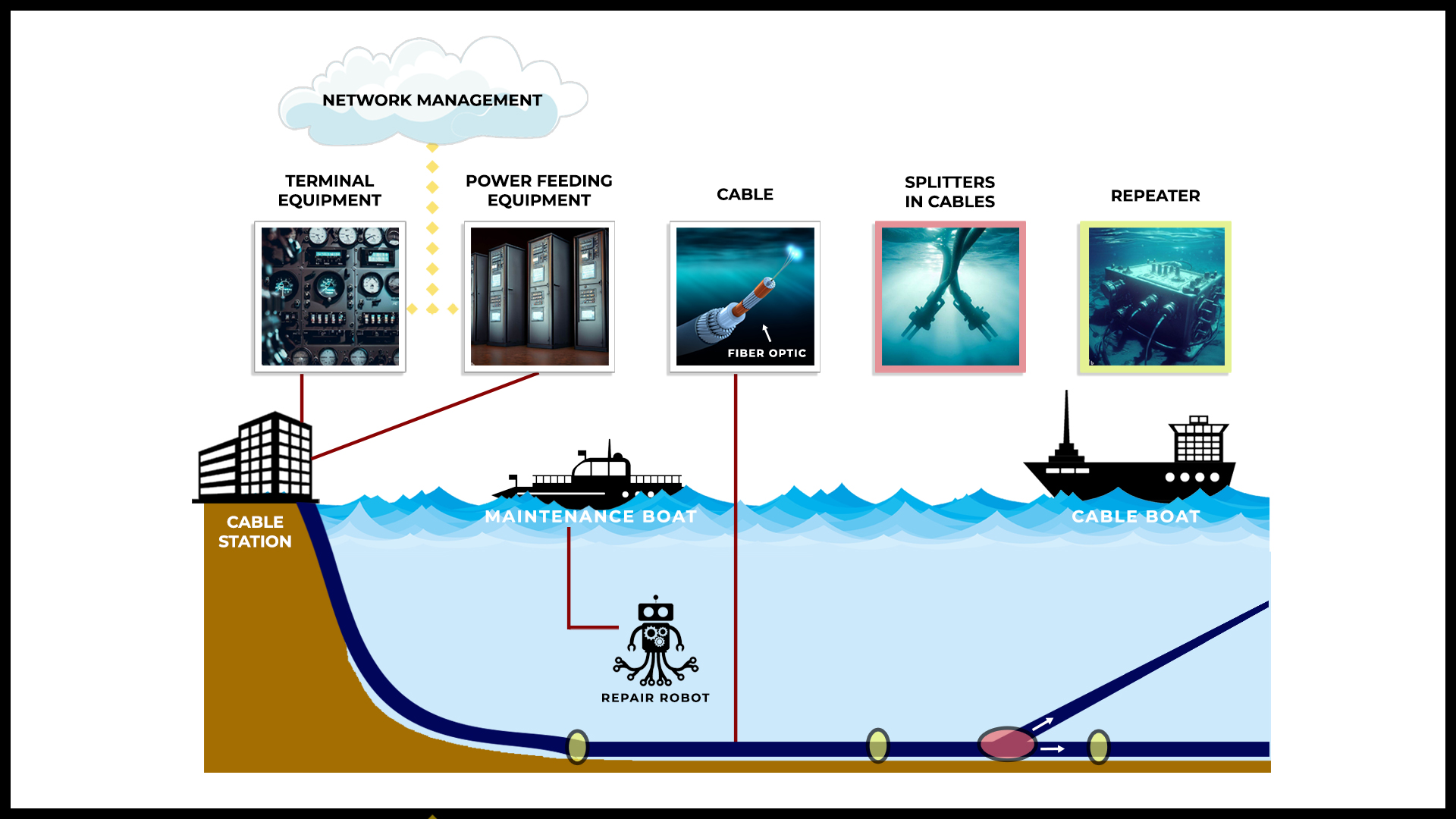Figure 1
By John Cronin
To Download a Free PDF of this Article Click Here (email required).![]()
This paper evaluates the Intellectual Property of the submarine cable space. In the intricate landscape of the submarine cable sector, a deeper exploration into the realm of Intellectual Property (IP) trends unveils crucial insights. This paper evaluates the IP landscape that underpins the dynamic developments within the region’s submarine cable domain. The strategic positioning of Brazil, Colombia, Chile, and Argentina as key landing points and hubs for submarine cable networks accentuates the significance of understanding the IP trends shaping this transformative sector.
The Study Area
Our analysis delves into a comprehensive examination of diverse critical technology areas within the submarine cable space. Figure 1 illustrates these areas as focal points of scrutiny to unravel the intricate tapestry of IP dynamics that impact the sector.
Data Analysis
This foundational exploration reveals a staggering 4,062 patent filings within our initial search. We discuss how these searches are done to give the reader proper context.
In a bold drive towards innovation, the sector’s growth trajectory stands out, manifesting a remarkable 7-fold increase in patent filings for a decade. This surge mirrors the vibrant landscape of high-tech innovation, placing the submarine cable sector on par with other groundbreaking technological domains we have studied for over 25 years! The profound implications of this exponential growth encapsulate heightened innovation, robust research and development undertakings, intensified competition, emerging complexities, and a burgeoning market potential.
China’s Influence and Jurisdictional Insights
The geographical distribution of patent filings, a compelling narrative of IP dynamics, unveils China’s dominant position. With China at the helm, South American nations find themselves outside the top 5 countries in patent filings, underlining their formidable challenge in securing a prominent role in this evolving landscape. This delineation based on Jurisdiction echoes the diverse legal frameworks that underpin patent laws. These frameworks encapsulate exclusive rights, jurisdictional scope, extraterritorial reach, and intricate cross-border enforcement mechanisms, shaping the interaction between innovation and legal protection.
Moreover, the territorial limitations of patent rights, whether within the confines of a nation’s borders on international waters or below ground, intertwine with the submarine cable industry’s landscape. The intersection of intellectual property, technology, and maritime regulations forms a unique matrix that impacts territorial waters and beyond.
An IP Strategy to leverage business models and investments is crucial!
In this multifaceted journey through IP trends, our exploration offers a comprehensive vantage point to grasp the strategic significance of IP within the submarine cable sector across Brazil, Colombia, Chile, and Argentina. The interplay between innovation, Jurisdiction, and territoriality provides a roadmap to navigate the evolving landscape that connects these nations as strategic landing points and hubs in the dynamic world of submarine cable networks.
The Study Parameters
The IP space we evaluated was to look at various critical areas of the submarine cable space. Figure 1 provides an example of those areas.
Performing a patent search using keywords involves searching through patent databases and documents to identify relevant patents based on specific terms or phrases related to the subject you are interested in. This search aims to find existing patents that may be relevant to your area of interest. The process can be broken down into several steps:
- Keyword Identification: We identify relevant keywords and phrases that describe the technology, concept, or subject you are researching. These keywords should capture the essence of what you are looking for.
- Database Search: We use these keywords to search various patent databases. These databases contain vast collections of world patent databases.
- Keyword-Based Search: We input selected keywords using our proprietary search software and use the chosen database’s search interface. The search engine then scans its patent documents to find those containing your specified keywords.
- Sub-Area Identification: By collecting relevant patents, we analyze them to identify sub-areas or specific aspects of the technology. This involves closely examining the content of the patents and identifying common themes, features, or variations within the technology. This step helps break down our initial broad topic into smaller, more specific categories.
- Subcategory Keywords: For each sub-area you identify, we create a set of keywords that are specific to that sub-area. These keywords should capture the nuances and details of the technology within that subcategory.
- Refined Search: We perform another search using the subcategory keywords generated. This refined search helps find patents more closely related to the specific sub-areas you are interested in.
- Bucketing or Categorization: Based on the refined search results, we “bucket” or categorize the patents into subcategories according to the different aspects or variations of the technology you have identified. This process helps organize the patents in a way that makes it easier to analyze and understand the technology landscape within your chosen domain.
Data Analysis
Our basic search found 4062 patent filings that resulted in 2431 single families. “Patent families” represent a group of related patents that protect the same invention across different countries or regions. They help inventors and legal professionals understand the international scope of patent protection and navigate the complexities of filing patents in multiple jurisdictions. Comparatively, this represents a large drive towards innovation as a technology space.
Innovation growth is 7X.
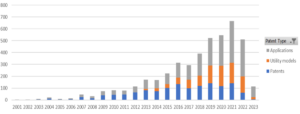 The rate of invention in this space is 7X, which competitively puts this up with some of the other very high-tech areas. A significant increase in filed patents, such as 7 times (7x) in 10 years, generally indicates an innovative and dynamic technology space. This level of patent growth suggests several key points:
The rate of invention in this space is 7X, which competitively puts this up with some of the other very high-tech areas. A significant increase in filed patents, such as 7 times (7x) in 10 years, generally indicates an innovative and dynamic technology space. This level of patent growth suggests several key points:
- Innovation: A rapid increase in filed patents suggests much innovation within technology. New inventions, improvements and novel ideas are being developed and protected through patents.
- Research and Development (R&D): Patent filings often reflect an industry’s research and development activity level. Substantial patent growth indicates that a considerable amount of R&D investment is happening to develop and refine technologies.
- Competition: When the number of patents grows significantly, it can indicate a competitive environment where different companies or individuals are vying to secure their intellectual property and gain a competitive advantage.
- Complexity: A higher rate of patent growth might suggest that the technology space is becoming more complex, with various subfields, niche areas, and specialized innovations.
- Market Potential: A surge in patent activity can also suggest that the technology space is gaining attention from investors, businesses, and stakeholders who see the potential for growth and financial returns.
- Technological Advancements: The patent growth might signify breakthroughs and advancements in the field, leading to new products, services, or solutions.Top of Form
China takes the lead.
The patent filings in the study by Jurisdiction show that it is dominated by China, with Korea, the USA, and others as distanced followers. South American countries do not have enough patents to make the top 20 countries—the distribution of patent filings based on different jurisdictions (countries or regions) in a particular study. Chinese patents were 1100 filings of a total of 4062 patents.
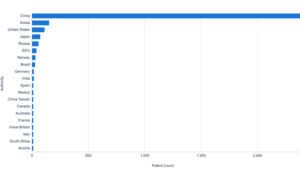
- Patent Filings by Jurisdiction: This refers to the number of patent applications submitted to the respective patent offices of various countries or regions.
- China Dominating the Filings: China has the highest number of patent filings compared to any other country. This indicates that a significant portion of the total patent applications in the study come from China.
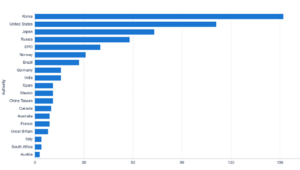
- Korea, USA, and Other Followers: While Korea and the United States (USA) are also among the top countries for patent filings, China is significantly ahead in the number of filings. Other countries also submit patent applications but are not reaching the same level as China.
- South American Countries: South American countries are not among the top 20 countries regarding patent filings. This means that, in the study, these countries have submitted fewer patent applications than countries like China and the USA. Brazil and Chile have 40 or so patents, and all other areas of South America have one or none. Therefore, there is a huge white space in South America for patents.
How does Jurisdiction impact IP studies?
Patent laws and regulations can vary significantly from country to country, but some general principles apply to the rights granted by patents and their Jurisdiction. When it comes to making, using, and selling patented inventions, here is an overview:
- Exclusive Rights: A patent grants the patent holder exclusive rights to make, use, sell, or import the patented invention for a certain period (usually 20 years from the filing date of the patent application). These exclusive rights are territorial, meaning they apply within the Jurisdiction of the country where the patent is granted.
- Jurisdiction: Patents are granted by individual countries or regions. Each country has its own patent office and patent laws. If you want patent protection in a specific country, you must file a patent application with that country’s office. For example, if you want patent protection in the United States, you will file a patent application with the United States Patent and Trademark Office (USPTO).
- Extraterritorial Reach: Patents are only protected within the country where they are granted. For instance, if you have a U.S. patent, you can prevent others from making, using, selling, or importing your patented invention in the United States. However, your U.S. patent does not prevent others from doing these activities in other countries. You must obtain patents in those other countries if you want similar protection.
- Cross-Border Enforcement: Enforcing patent rights across borders can be complex. If someone infringes your U.S. patent in a foreign country, you must use that country’s legal system to enforce your rights. Some international agreements, like the World Trade Organization’s Trade-Related Aspects of Intellectual Property Rights (TRIPS) Agreement, provide a framework for enforcing intellectual property rights across borders.
- Parallel Importation: Some countries allow parallel importation, which means that if a patented product is legally sold in one country, it can be imported and sold in another country without the patent holder’s consent. This can affect the ability to control the distribution of patented products across different markets.
How does the Jurisdiction of patents affect the submarine cable industry in South America?
The territorial scope of a patent is generally limited to the political boundaries of the country where the patent is granted. This means that the patent rights apply only within the borders of that specific country and do not extend beyond its geographic limits, whether into space, international waters, or underground.
Here is how this applies in different physical scenarios:
- Space: Patents are typically limited to the Jurisdiction of the Earth. While outer space is a subject of international law and treaties (such as the Outer Space Treaty), the territorial reach of a patent does not extend into space. Activities in outer space may be governed by international agreements and space law rather than individual patent rights.
- International Waters: Similarly, patent rights do not extend into international waters. Activities in international waters are often governed by maritime law and international agreements, and patents are not applicable in this context.
- Underground: The territorial limitation also applies underground. Patent rights are generally limited to activities within the country’s boundaries where the patent is granted and do not extend to activities beneath the ground.
Here is how IP affects territorial waters in South America
- South America encompasses multiple countries, each with its territorial waters. The extent of territorial waters varies from country to country based on international maritime law and bilateral agreements. Here are the approximate ranges of territorial waters for some of the countries in South America:
- Brazil, Argentina, Chile, Venezuela, Columbia, and Uruguay: They claim territorial waters extending up to 12 nautical miles (approximately 22.2 kilometers) from its coastline.
- Peru, Ecuador, claims territorial waters extending up to 200 nautical miles (approximately 370.4 kilometers) from its coastline, following the United Nations Convention on the Law of the Sea (UNCLOS) guidelines for an exclusive economic zone (EEZ).
- Ecuador: Ecuador claims territorial waters extending up to 200 nautical miles (approximately 370.4 kilometers) from its coastline, following UNCLOS guidelines.
- Paraguay and Bolivia: Since these countries are landlocked, they do not have direct access to territorial waters. However, they may be interested in rivers and bodies of water subject to international agreements.
Here is how IP affects territorial waters in South America
- Most of the technology areas shown in Figure 1 could be covered by patent protection in a country, for instance, cable patents onshore in a country, so patents on cables would be valid for enforcement. Of all the categories, repeaters are less likely to be with territorial waters if their distances can be > 12 miles, so the last repeater could be outside the country’s boundaries. All Cable House onshore technology would be valid for enforcement in a country. Even maintenance, if done within territorial waters, would be enforceable.
Patents in South America
Brazil and Chile have 40 or so patents, and all other areas of South America have one or none. Therefore, there is a huge White Space in South America for patents.
Patents vs Assignee
A look at the top assignees shows the top 20, mostly an array of various types of Chinese companies.
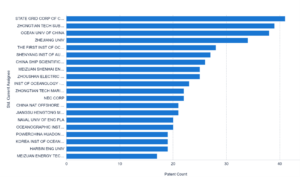
If we take China’s Jurisdiction out of the data, we have companies like NEC, Siemens, Atlas, and LG as top players, as well as institutions of countries.
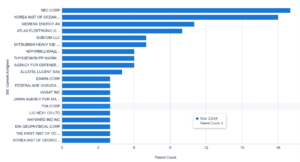
Patents By Technology Areas
By analyzing the technology areas of Figure 1, we find the overall patent distributions below. Cables have by far the most patents (266) compared to the following areas with 50 or so patents. Fiber optics, within cables, have 61. Interestingly, repeaters have far less patents -32. There is little to none on power and terminal equipment.
It is evident from an IP strategy that one could judiciously patent areas in the right countries and technologies to enhance a business model and investment in that country. What is required is an in-depth IP Strategy![1]
[1] IP Strategy is a service of ipCapital https://www.ipcg.com/thought-leadership/invent-anything-podcast/
Episode 21 – IP Strategy for Businesses and Inventors
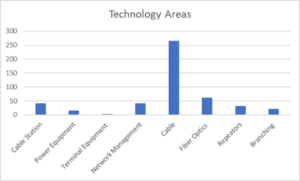
Specific Technology Areas By Assignees
- Cable Station – 42
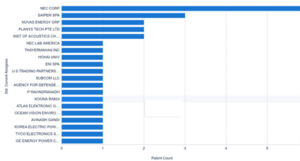
2. Power Equipment – 15
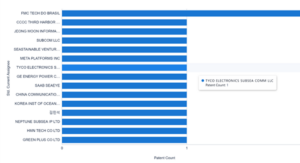
3. Terminal Equipment – 3
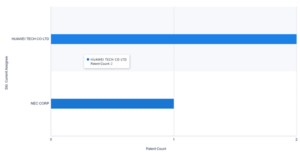
4. Network Management – 42
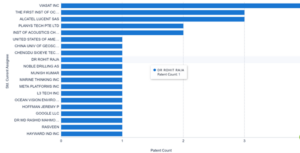
5. Cable – 266
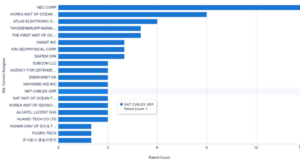
6. Fiber Optics – 61
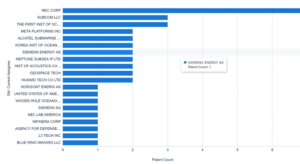
7. Repeaters – 32
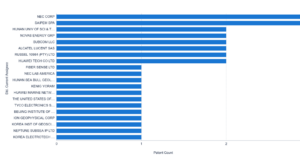
8. Branching – 21
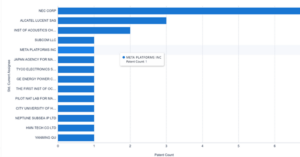
9. Maintenance – 8
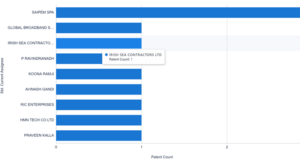
Conclusion: Unveiling the Strategic Landscape of Submarine Cable Intellectual Property Trends
This paper is a comprehensive journey into the world of Intellectual Property (IP) within the intricate realm of submarine cable networks. The exploration of IP trends in this transformative sector has yielded critical insights that underscore Brazil, Colombia, Chile, Argentina, and South America’s strategic importance as pivotal landing points and hubs for submarine cable networks. As the global digital landscape expands, these nations’ roles are further emphasized, making understanding IP dynamics paramount.
Delving into the depths of the study, our analysis illuminated the diverse critical areas within the submarine cable space. This holistic examination provided a lens to decode the intricate IP tapestry that shapes this technological sector’s evolution.
The data analysis phase uncovered a trove of intellectual property in 4,062 patents. This investigation not only shed light on patent databases but also highlighted the significance of patent families in understanding the innovations contributing to the dynamic submarine cable industry.
A standout revelation emerged in the form of a remarkable 7-fold increase in patent filings over a decade, placing the sector at the forefront of high-tech innovation. This exponential growth signifies intensified innovation, research and development endeavors, competitive dynamics, and burgeoning market potential. Notably, the dominance of China in patent filings underscored a broader trend that shapes the landscape of submarine cable intellectual property.
The interplay between jurisdiction and intellectual property laws was a pivotal aspect explored in this paper. The territorial boundaries defined by patent jurisdiction intricately weave into the unique matrix of submarine cable networks, maritime regulations, and global commerce. Whether in international waters, outer space, or underground exploration, understanding Jurisdiction’s impact on patent protection is vital to grasping the industry’s complexities.
As we conclude this multifaceted journey through IP trends, it becomes evident that deciphering the intellectual property landscape is paramount for South American nations aspiring to thrive in the submarine cable domain. The strategic positioning of Brazil, Colombia, Chile, and Argentina converges with the technological advancements, jurisdictional nuances, and patent dynamics that pave the way for innovation and connectivity in this dynamic sector.
Note: The data and further analysis can be obtained by sending a request to ipCapital Group via info@ipcg.com.

